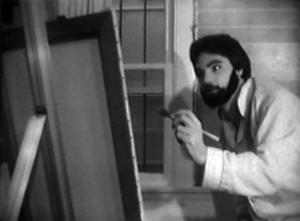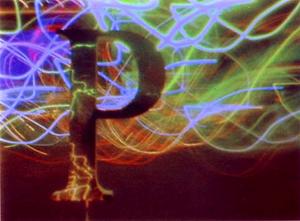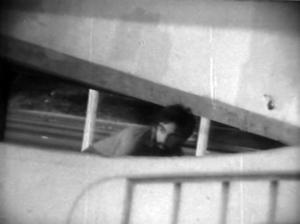|
|
|
Low Budget Film
 |
| Decoy For Terror |
Using the Ultimate Guerilla Style of Filmmaking, the Super-8 format.
For more Information
on my 20 plus years
making films and videos,
please visit Alex LOGIC.
I am also an ideas person,
and an excellent collaborator.
The Super-8 film format offers the low budget guerilla filmmaker an intriguing low cost option for shooting a feature on film. While many digital video productions grapple with diverse methods for trying to make digital video look like film, Super-8 is film and retains the film look even when transferred to video.
For a Guerilla super-8 film project to be cost effective, a very small crew is usually the first pre-requisite. The smaller the crew, the faster the crew can move from location to location.
Pre-loaded Super-8 film cartridges help reduce the assistant camera crew size since no changing bag, a battery charging station or pre-loaded film magazines are needed, and virtually no time is lost when changing film cartridges.
However I still recommend a camera assistant for keeping track of the various film stocks that have shot, including writing down how much film is left on a cartridge. Sometimes the shoot requires switching film stocks before the prior super-8 film cartridge has been finished and having a camera assistant to deal with this can prove very effective. I use a digital frame counter so that I can stay on top of exactly how much film is left in a cartridge if I have to remove it before the film cartridge is completely used up.
It is also easier to keep several different super-8 filmstocks in inventory because the cost per film cartridge is very low. 50 foot Super-8 film loads are either 2 minutes and thirty seconds at 24 frames per second, or 3 minutes and 20 seconds at 18 frames per second.
Changing a Super-8 film cartridge is actually faster than with any motion picture film format or videotape format ever invented. The Super-8 camera power supply usually consists of 2, 4, or 6 double AA batteries usually located in the camera handle (but not always).
Kodak's release of two motion picture negative film stocks in Super-8, Vision2 200T Negative and Vision3 500T Negative have helped pave the way for the Super-8 low budget guerilla style of Feature Filmmaking. I recently lit a night time scene that included a pool area and accompanying garden with one 1K light and two portable battery operated HMI frezzi mini arc lights. I used 500T negative and I was very pleased with the results. You can view short clips of this film at dalidalidali although that particular scene is not in these clips.
Ironically, for that particular pool scene I desperately needed a camera assistant to tell me if I was using 3000 ASA BW Polaroid film for exposure testing, or the 100 ASA BW Polaroid film. I should have opened the camera up an extra f-stop but after shooting a very long day and night with no actual camera assistant, I did underexpose that scene more than I would have liked because I was no longer sure which polaroid film stock I was using for my test frame shots.
Sometimes true guerilla filmmaking can require spending more money upfront on quality equipment that will in turn save money over the course of the entire production. Purchasing certain productin equipment can reduce the overall size of your crew, rental costs, and filming errors that require additional takes. It is imperative to purchase the type of quality film support equipment that retains solid resale value and also has a proven track record for saving you money during your actual production.
After your film is shot, you may decide to resell the quality equipment you purchased because you no longer need it. In some instances you will find the resale value close enough to the purchase price to make use of the gear during the shoot a significant savings over renting.
Certain equipment, such as quality tripods, and portable lights and batteries may hold resale value longer and better than a camera will. However, you may find that because Super-8 cameras are inexpensive to begin with their before and after costs may be considered neglible as well, provided they are taken care of by you during the shoot.
|
 |
| The Letter P with Super-8 Time Exposure |
Low Cost Lighting Strategies Revealed...
When it comes to lighting solutions that will save you money, DC powered lights can save you money in many ways. DC lights cost less than standard AC lights and they require less crew to operate. DC lights tend to generate less heat as well!
Frezzolini makes a whole line of DC powered lights both in the Tungsten and HMI variety. To power your DC lights, Frezzolini and Anton Bauer Batteries both have a solid reputation. The advantage of using batteries to power D.C. lights is that no cables have to be run to AC outlets. D.C. lights can instantly be picked up and moved to a new angle since the battery power supply can usually be located at the base of the light stand.
Newer battery technologies such as Lithium have made batteries more lightweight than ever and therefore easier to move when moving your DC lights. Quick charge battery technology allows one to charge one set of batteries while another set is in use.
Lead batteries cost significantly less than, weigh more and are more powerful than lithium, but require a much longer recharge cycle than lithium ion. You must also make sure you use a fuseable link with lead batteries as well and take proper care of them at all times. If you discharge a lead battery too far, (below 11.2 volts for a 12 volt lead battery) you can permanently damage them.
The primary disadvantage to DC lighting is the lights are generally non-focusable and the lights source is smaller in diameter. Smaller diameter light sources produce a harder light than larger diameter light sources do. Many DP's shy away from small light sources because they create harsh shadows.
Bouncing DC powered lights significantly reduces light output so one may be forced to do more directional lighting. However, the good news is film handles directional lighting much better than video, and this should allow your guerilla film production to move to new locations and re-light faster.
Anton Bauer and Frezzolini batteries apparently will still retain a decent portion of their value (assuming you don't hold on to them for more than 6 months to a year) even if one has recharged them 50-75 times. If you have charged your batteries 50-75 times, that means you have used your batteries for guerilla lighting set-ups enough times and have probably saved money by reducing your lighting crew personnel costs and rental costs as well.
I have used Frezzolini 24W HMI's with Anton Bauer Dionic 90 batteries and find them to be an ideal match. However the Dionic 90's might be considered pricey. But if you are able to do your lighting set-ups faster your battery and lighting costs are amortized each and every day you use them. Since most high end batteries should retain 50-65% of their value if they are kept in good shape and you bought them new, it's clear to see that these items will have paid for themselves by the time your film completes the production cycle.
I can't stress enough to never try any lighting set-up without first consulting with an experienced film production veteran and getting their approval as to how you plan on using your DC powered lighting kit. Never try any lighting set-up for the first time on a film shoot and don't have anyone handle your batteries or lights who doesn't have any prior experience with lights or batteries. Always keep your lights and batteries away from water, heat, fire, and flammable gasses. I also DO NOT recommend making your own batteries and please realize that ALL BATTERIES should have fuseable links that help prevent the battery from overloading and possibly exploding.
If you cannot afford portable Frezzi HMI lights, you can use standard DC lights with dichroic filters to emulate daylight light. One disadvantage of dichroic filters with 12 volt tungsten dc lights is they will give off more heat than a portable HMI mini arc will, but 12 volt dichroic tungsten dc light should give off significantly less heat than a 120 volt light will.
Remember, 12 volt, DC lights with dichroic filters is primarily for low budget filmmaking where you need to match daylight color temperature and can't afford to pay mini-arc HMI's, or for a crew, or you don't want to take advantage of people by having them work for free or very little pay. However, making a low budget film is NEVER an excuse to not practice SAFE lighting and film shooting procedures.
There should always be at least two people on the set who's job it is to simply observe and monitor the set and surrounding area for any unsafe or potentially dangerous situations. You really should have two people monitoring the set and surrounding areas because as soon as one of these two people becomes involved in a task, a back up person should still be available to monitor the set. What if you ask one of your two monitors to run an errand, without a second monitor on the set you have nobody observing the set for safety purposes, and that is UNACCEPTABLE.
You cannot count yourself as one of the on set safety monitors since your vision can be limited to what you see through the camera or as a director observing the actors during a take.
|
 |
| Decoy For Terror |
Sound Recording Secrets Revealed and what Tripod should you use?
When it comes to sound, if you are shooting a scene in what is considered a noisy area, consider pre-recording the actors dialogue soundtrack ahead of time and then playing back the sound on location in the same manner a music video is shot with on location lip sync. Yes, this method does limit the actors pacing to what they already recorded ahead of time, but your shooting time may be reduced by a phenomenal amount and you will save film as well.
I'm not suggesting you do every scene the lip sync way, but if you have an upcoming tough day of shooting at a location and are concerned that someone not from your set will purposely begin mowing their lawn while you film, it won't matter! The ultimate revenge against uncontrollable noise that can conspire to ruin your filming schedule can now be controlled by pre-recording your dialogue takes!
A word of caution about this lip sync technique. An experienced actor will probably be offended by the idea of having to pre-record their dialogue and then lip sync their dialogue on location whereas the younger, new to the business actor will probably welcome the opportunity.
-----------------------------
A Sachtler tripod should retain 70-75 percent of it's resale value 3-4 years down the road. The advantage of a Sachtler tripod is it will assist you in achieving smoother pans and tilts which translates into less total takes. Less total takes means less film stock is consumed, which means you will spend less on film processing and film transfer costs, which then translates into less editing nightmares to fix in edit, while also achieving a higher overall production value.
Meanwhile, when your production is done, you can choose to sell your sachtler and you should realistically get at the very least 50% back, and probably anywhere between 50-75% back of what you paid for the Sachtler. The 75% number is realistic if you sell it as soon as you no longer need it for your shoot and haven't damaged or dinged your tripod up.
Lets not forget Bogen Tripods either, which actually cost a lot less than Sachtler and while not as ideal as the Sachtler, may be a great value since they are much less expensive. If you go with a Bogen, at the very least get the center ball head design with the instant centering column ball joint adjustment.
Super-8mm.com - Super-8mm Low Budget Feature Filmmaking Techniques
Page-1 Super-8 Links, Overview & Methods.
Page-2 Super-8 Guerilla Filmmaking.
Page-3 Indoor & Outdoor Locations.
Page-4 Super-8mm Film Stock Strategies.
Page-5 Super-8 Production News & Notes.
Page-6 A Good SoundTrack Can Make Your Film.
Page-7 Using Quiet Super-8 Cameras.
Page-8 Best Script Concepts for Super-8mm.
Page-9 Acquiring Same Model Super-8 Cameras.
Page-10 One Stop Super-8 Film Labs.
Super-8mm.net - The Many Advantages of Super-8mm Filmmaking are Revealed.
Page-1 Super-8mm Overview.
Page-2 Super-8mm Film Advantages Explored
Page-3 Super-8mm Film Production News
Page-4 Music Video Techniques.
Page-5 Labs & Transfers.
Page-6 8mm Film Subscription Magazines.
Page-7 Flicker Super-8 Shooting Strategies
Page-8 Using Polaroids.
Page-9 Super-8 Cameras.
Page-10 Super-8 Forums.
|
|
|
|
|